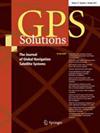基于机器学习的空间域多路径建模在GNSS短基线处理中的应用
IF 3.9
1区 地球科学
Q1 REMOTE SENSING
引用次数: 0
摘要
多路径是阻碍卫星导航系统高精度数据处理的主要未建模误差源。传统的多路径缓解方法,如恒星滤波(SF)和多路径半球映射(MHM),都有一定的缺点:它们要么不容易使用,要么对多路径缓解不够有效。在本研究中,我们提出了一种基于机器学习(ML)的多路径缓解方法。将多径建模作为一种回归任务,在空间域内对多径误差进行方位角和高程拟合。我们收集了30天的1 Hz GPS数据来验证所提出的方法。总共形成5条短基线,并从拟合后残差中提取多径误差。利用目标日前5天的残差构建基于ml的多径模型以及观测域的SF和MHM模型,然后进行多径校正。发现XGBoost (XGB)方法优于SF和MHM方法。该方法对GPS P1、P2、L1和L2观测值的剩余降噪率最高,分别为24.9%、36.2%、25.5%和20.4%。采用基于xgb的多径修正后,东、北、上三分量的运动定位精度分别提高了1.6 mm、1.9 mm和4.5 mm,分别比原解提高了20.0%、17.4%和16.7%。利用30秒采样数据和低成本设备的数据进一步验证了基于ml的多路径模型的有效性。我们得出结论,基于机器学习的多径缓解方法是有效的,易于使用,并且可以通过在模型训练期间添加辅助输入特征(如信噪比)轻松扩展。本文章由计算机程序翻译,如有差异,请以英文原文为准。
Machine learning-based multipath modeling in spatial domain applied to GNSS short baseline processing
Abstract Multipath is the main unmodeled error source hindering high-precision Global Navigation Satellite System data processing. Conventional multipath mitigation methods, such as sidereal filtering (SF) and multipath hemispherical map (MHM), have certain disadvantages: They are either not easy to use or not effective enough for multipath mitigation. In this study, we propose a machine learning (ML)-based multipath mitigation method. Multipath modeling was formulated as a regression task, and the multipath errors were fitted with respect to azimuth and elevation in the spatial domain. We collected 30 days of 1 Hz GPS data to validate the proposed method. In total, five short baselines were formed and multipath errors were extracted from the postfit residuals. ML-based multipath models, as well as observation-domain SF and MHM models, were constructed using 5 days of residuals before the target day and later applied for multipath correction. It was found that the XGBoost (XGB) method outperformed SF and MHM. It achieved the highest residual reduction rates, which were 24.9%, 36.2%, 25.5% and 20.4% for GPS P1, P2, L1 and L2 observations, respectively. After applying the XGB-based multipath corrections, kinematic positioning precisions of 1.6 mm, 1.9 mm and 4.5 mm could be achieved in east, north and up components, respectively, corresponding to 20.0%, 17.4% and 16.7% improvements compared to the original solutions. The effectiveness of the ML-based multipath model was further validated using 30 s sampling data and data from a low-cost device. We conclude that the ML-based multipath mitigation method is effective, easy to use, and can be easily extended by adding auxiliary input features, such as signal-to-noise ratio, during model training.
求助全文
通过发布文献求助,成功后即可免费获取论文全文。
去求助
来源期刊

GPS Solutions
工程技术-遥感
CiteScore
8.10
自引率
12.20%
发文量
138
审稿时长
3.1 months
期刊介绍:
GPS Solutions is a scientific journal. It is published quarterly and features system design issues and a full range of current and emerging applications of global navigation satellite systems (GNSS) such as GPS, GLONASS, Galileo, BeiDou, local systems, and augmentations. Novel, innovative, or highly demanding uses are of prime interest. Areas of application include: aviation, surveying and mapping, forestry and agriculture, maritime and waterway navigation, public transportation, time and frequency comparisons and dissemination, space and satellite operations, law enforcement and public safety, communications, meteorology and atmospheric science, geosciences, monitoring global change, technology and engineering, GIS, geodesy, and others.
GPS Solutions addresses the latest developments in GNSS infrastructure, mathematical modeling, algorithmic developments and data analysis, user hardware, and general issues that impact the user community. Contributions from the entire spectrum of GNSS professionals are represented, including university researchers, scientists from government laboratories, receiver industry and other commercial developers, public officials, and business leaders.
 求助内容:
求助内容: 应助结果提醒方式:
应助结果提醒方式:


